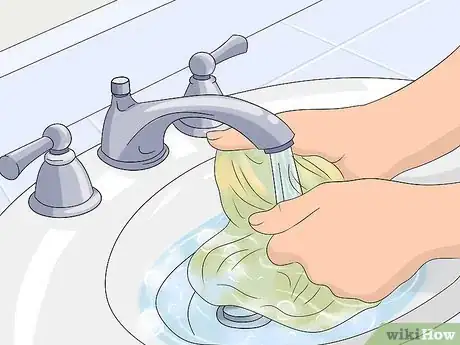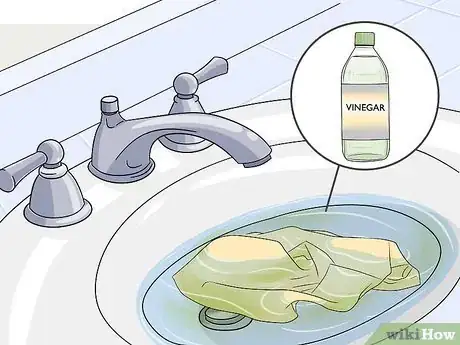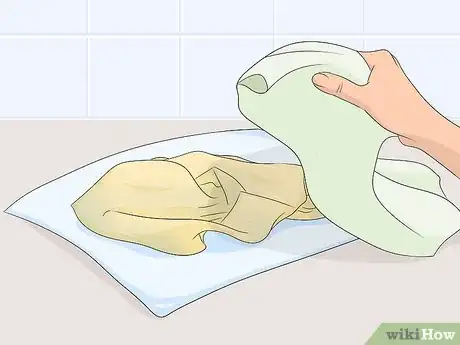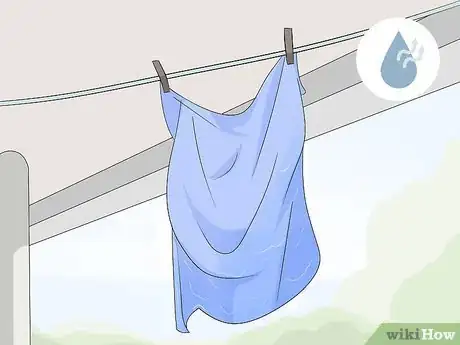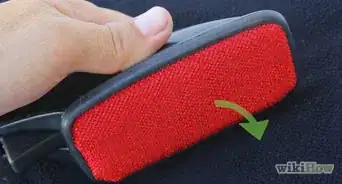This article was co-authored by wikiHow Staff. Our trained team of editors and researchers validate articles for accuracy and comprehensiveness. wikiHow's Content Management Team carefully monitors the work from our editorial staff to ensure that each article is backed by trusted research and meets our high quality standards.
There are 7 references cited in this article, which can be found at the bottom of the page.
This article has been viewed 21,871 times.
Learn more...
Scarves come in a variety of sizes, colours, shapes, patterns, and most importantly, fabrics. Different fabrics require different methods to keep them clean and smelling great. In addition, scarves tend to be an item often forgotten about when doing laundry but should be cleaned regularly. If for no other reason, your scarves are almost always up against your skin for extended periods of time and they cover your mouth and/or nose in the winter, even when you’re sick.
Steps
Hand-Washing Wool, Cashmere, and Silk Scarves
-
1Fill a sink or tub with cool water. Neither wool, cashmere, nor silk should be put in a washing machine. The movements of the machine are not gentle enough to wash your scarf without damaging it. Instead, find a sink, tub, or even bowl that will be large enough to completely submerge your scarf in water. Fill that sink, tub, or bowl with clean, cool water.
- Some washing machines have cycles designed specifically to gently wash wool. If your washing machine has such a setting, read the instruction manual before attempting to wash any of your wool scarves using this setting.
- Avoid using warm or hot water, as it may damage delicate fabrics.
-
2Add gentle laundry detergent to the water in the sink/tub. Once the sink, tub, or bowl is filled with cool water, add 1 tablespoon (15 mL) of gentle laundry detergent. Stir the detergent into the water using either a spoon or your hand. If you’ve used powder detergent, stir the water until all the powder has been dissolved.
- It is recommended that you use laundry detergent that is specifically made for handwashing purposes.
Advertisement -
3Submerge your wool, cashmere, or silk scarf in the water for 10 minutes. Once your sink, tub, or bowl of soapy water is ready, take your scarf and completely submerge it under the water. Squeeze your scarf while it’s under the water to ensure it soaks up as much water as possible. Swish the scarf around in the water several times. Allow your scarf to soak in the water for at least 10 minutes.
- Do not rub pieces of the scarf against each other; this may damage the fabric.
-
4Rinse your scarf in cool, clean water to remove all the detergent. Once your scarf has been washed, rinse the soap away using clean, cool water. You can run your scarf under a faucet rather than soaking it in clean water if you prefer. Do not rub or wring the scarf while rinsing it. You’ll know it’s rinsed when there are no more soap bubbles in the water.
- If you opt to rinse your scarf under a faucet, use gentle water pressure.
- You can squeeze the scarf while it’s being rinsed, just as you did when it was submerged in the water.
-
5Revitalize your silk scarf by soaking it in vinegar and water. Sometimes, after being washed, silk scarves lose their softness. One great way to revitalize your silk scarves is to soak them in a mixture of vinegar and water. You can either do this right away, or you can wait until your silk scarf has dried and you’ve inspected the fabric. Either way, add 1⁄4 cup (59 mL) of white vinegar to 1 gallon (3.8 L) of lukewarm water and submerge your scarf in the water for 30 minutes.
- To remove the vinegar smell from your silk scarf, rinse it in cool, clean water before setting it out to dry. You can rinse your silk scarf under a running faucet (with gentle pressure) until you can no longer smell the vinegar.
- You can repeat the vinegar rinse several times to revitalize your silk scarf if needed.
-
6Place your wet scarves between two towels to remove all excess water. Once your scarf has been washed and rinsed, place it between two clean towels and press down on the towels with your hands to squeeze out as much excess water as possible.
- Avoid rubbing or wringing out your scarves, but you can roll the towels up (with the scarf in between) as a way to squeeze the excess water out.
-
7Allow your scarves to air dry before putting them away or wearing them. For wool and cashmere scarves, place the scarf on a clean, dry towel and leave it to air dry. For silk scarves, hang them on a plastic hanger to air dry. You can put your scarves outside to dry, but avoid putting them in the direct sunlight.
- The length of time it will take your scarf to dry will differ depending on the type of material (wool will take longer than silk) and the location where you’ve placed the scarf to air dry (a humid basement will take longer than the dry breeze outside).
- Do not use a metal or wood hanger to dry a silk scarf. The metal and wood may damage the fabric.
-
8Iron your silk scarf while it’s still damp. Silk scarves should be ironed to remove the wrinkles that may have formed from the cleaning process. However, silk scarves should be ironed while they are still a little damp, not completely dry. Use only a warm setting on your iron with a silk scarf, not a hot setting.[1]
- Use a clean piece of white fabric between the iron and your silk scarf to protect your scarf. Also, iron on the ‘wrong’ side of the scarf, if it’s obvious which side is the ‘wrong’ side.
Machine-Washing Cotton and Polyester Scarves
-
1Use the gentle or delicate setting on your washing machine for cotton or polyester scarves. Before putting your scarf in the washing machine, check the label to ensure it is polyester or cotton. Also, check the label for any specific cleaning instructions from the manufacturer. If your scarf is polyester or cotton, it can be cleaned using the gentle or delicate cycle on your washing machine, in cold water, and with a gentle detergent.[2]
- Gentle detergent is any type of laundry detergent designed specifically for hand-washed items.
- You may want to place your polyester or cotton scarves into a mesh bag before putting them in the washing machine.[3]
-
2Hang your cotton or polyester scarves on a clothesline to air dry. Cotton and (non-fleece) polyester scarves should not be placed in the dryer, as the heat may damage the fabric. Instead, hang your cotton or polyester scarves up to air dry. You can also lay the scarves on a clean towel to dry, if you don’t have a place to hang them.[4]
- You can hang your scarves inside or outside to dry.
- Double-check the label on your scarf to determine if you can place your scarf in the dryer on a low heat setting. Some scarves may be a mix of fibres which can be placed in a dryer safely.
-
3Place your fleece scarf in the dryer on a low heat setting. Synthetic fleece is polyester but may require slightly different methods to wash and dry. A fleece scarf can go into the dryer after it’s been cleaned in a washing machine, but keep your dryer on a low heat setting to prevent damage.[5]
- It’s always a good idea to check the cleaning instructions on your scarf before putting it in a dryer.
- Do not dry clean, iron, or steam your fleece scarf; these methods may cause the fleece to melt (as fleece is polyester and polyester is essentially plastic).
Things You’ll Need
Hand-Washing Wool, Cashmere, and Silk Scarves
- Sink, tub, or large bowl
- Gentle laundry detergent
- White vinegar (optional)
- Dry, clean towels
- Plastic hanger
- Iron
Machine-Washing Cotton and Polyester Scarves
- Washing machine
- Gentle laundry detergent
- Mesh laundry bag (optional)
- Dryer
- Clothesline or dry, clean towels
References
- ↑ https://www.whowhatwear.com/how-to-iron-silk/slide3
- ↑ https://www.bustle.com/articles/113368-how-often-should-you-wash-your-scarf-to-keep-it-clean-through-winter
- ↑ https://www.esquire.com/style/mens-fashion/news/a52520/ask-a-clean-person-winter-essentials/
- ↑ https://www.bustle.com/articles/113368-how-often-should-you-wash-your-scarf-to-keep-it-clean-through-winter
- ↑ https://www.home-ec101.com/how-to-care-for-fleece/
- ↑ https://www.realsimple.com/beauty-fashion/clothing-care/laundry-guidelines-winter-clothes?slide=61977#61977
- ↑ https://www.chatelaine.com/style/dry-cleaning-hand-wash-clothes/
- ↑ https://www.cleaninginstitute.org/cleaning-tips/clean-home/ask-aci/ask-aci-cleaning-scarves



